Executive summary
The purpose of this project is to evaluate the application of the outsourcing strategy at ADNOC Distribution service stations. The paper focuses on the maintenance function within the service stations. The research paper reviews the most important aspects associated with the outsourcing strategy concerning the maintenance function. This goal is achieved by evaluating the advantages and disadvantages that organizations encounter in implementing the outsourcing strategy. The first part of the paper outlines background information relating to the ADNOC Distribution, a statement of the issue facing the organization in implementing the outsourcing strategy, scope, rationale, objectives, and limitation of the study. The second section involves a comprehensive literature review outlining the benefits and risks encountered in the course of implementing the outsourcing strategy. Moreover, a review of the methodology that organizations can adopt in implementing the outsourcing strategy is conducted. The methodology used in conducting the study is evaluated in the third section. The fourth section entails a case study analysis of how ADNOC Distribution has implemented the outsourcing strategy. Finally, a conclusion and some recommendations regarding the firm’s outsourcing strategy are made.
Introduction
Background
Abu Dhabi National Oil Company [ADNOC] Distribution was established in 1973 in the United Arab Emirates’ oil and gas industry. The corporation operates as a government-owned entity and it has a diversified product portfolio, which is comprised of crude oil and oil products such as petrochemicals and natural gas. The firm has attained significant market recognition due to its effective national and international marketing activities. ADNOC Distribution has also derived market recognition due to its focus on providing customers with high-quality petroleum products. Additionally, the firm has invested extensively in product distribution, hence becoming one of the largest and most innovative oil and gas firms in the Gulf region. ADNOC Distribution operations are comprised of several business units. Its effective distribution has greatly improved the level of reliability of its products. Furthermore, the firm’s market success arises from the investment in developing a diverse workforce (ADNOC 2015).
Currently, the firm has a human resource base of over 9,000 employees, which is comprised of workers from over 50 different countries. ADNOC Distribution has established over 300 service stations located in different emirates. Operations within the service stations are inspired by the traditional Arabic architecture, which reflects the UAE heritage. The service stations provide different products and services such as petroleum products [diesel fuel and gasoline], oil change services, automatic car washing, and car care center. The firm is focused on meeting the energy needs of different industries such as aviation, sea and air transport, construction, manufacturing, and utility industries, which highlights the commitment to product diversification. ADNOC Distribution ensures that its products are eco-friendly.
ADNOC Distribution offers car maintenance services through its Autoserv unit. The unit has positioned itself as the ideal destination for multi-brand car maintenance services in the Gulf region. According to ADNOC (2015, par. 7), Autoserv unite has ‘developed a broad menu that includes both regular servicing and fast repairs’. The service menu includes tire change, brakes and battery replacement, car wash, installation of thermal insulators, and AC repair. Clients have an opportunity to watch the different stages of their vehicles’ maintenance processes. The service stations also comprise different convenience facilities such as fast-food outlets, shops, cafes, and mosques. The inclusion of these facilities has improved the ADNOC’s ability to satisfy its customers. ADNOC Distribution is dedicated to developing its workforce’s expertise through continuous employee training to promote its service delivery process. Moreover, the firm intends to offer its maintenance services in all the UAE regions by establishing additional Autoserv centers. The firm has identified strategic locations in Abu Dhabi, viz. Yas Island and Mushrif and in the Northern Emirates (ADNOC 2015).
The firm’s maintenance workshops are fitted with different equipment, which enhances its ability to undertake the vehicle maintenance function. Thus, one can argue that ADNOC Distribution is an asset-intensive entity. The extent to which an organization maintains its facilities determines the life of the asset, hence the overall performance. In a bid to improve its productivity, the firm’s management team must ensure that its facilities and equipment are reliable to promote maintenance practice. Therefore, asset-intensive companies must improve their machinery maintenance practices, which underscores the importance of implementing an effective strategy.
In line with its quality policy, ADNOC Distribution has integrated the concept of strategic outsourcing in executing its maintenance function. Agha, Alrubaiee, and Jamhour (2011) emphasize that the objective of strategic outsourcing is to enhance an organization’s competitive advantage, and thus it is structured in line with long-term strategies. Strategic outsourcing aims at attaining an optimal market position hence promoting an organization’s long-term success. Agha, Alrubaiee, and Jamhour (2011) affirm that several advantages are associated with outsourcing. Some of the core benefits include cost and time saving, achieving economies of scale, operational flexibility, and risk-sharing. Cost-saving constitutes the main motivation for strategic outsourcing.
Outsourcing has become an accepted business model in the global oil and gas industry. Insinga and Werle (2000, p. 59) contend that the ‘contemporary oil and gas industry continues to struggle in finding a complicated balance between rising global demand, diminishing known resources, and maintaining distribution and operating costs’. Conversely, Davis (2004) argues that outsourcing provides business entities with an opportunity to focus on their core business operations, hence enhancing resource utilization.
ADNOC Distribution has mainly integrated the concept of outsourcing in offering non-core maintenance activities. Some of the maintenance activities that the firm has outsourced relate to the maintenance of air conditioning units, automatic sliding doors, neon lights, roll shutter, CCTV, fuel dispensers, and air gauge maintenance coupled with the calibration of fuel dispensers and air gauge. The firm outsources the maintenance function from different companies such as Emirates Transport. The partnership has considerably contributed to the firm’s effectiveness and efficiency in offering automobile maintenance services by international standards.
Problem statement
An organization’s outsourcing decision should be based on its needs, strategic interests, and goals. Recognizing the benefits associated with outsourcing only marks the starting point in achieving optimal maintenance function. Thus, the organization’s management team must develop effective outsourcing decision-making criteria. Implementing the outsourcing strategy is complex. This aspect arises from the view that the applicability of a particular outsourcing strategy varies from one industry to another. Thus, a case-by-case approach should be adopted in applying the outsourcing concept.
Tayauova (2012) affirms that despite the prominence of outsourcing in promoting business performance, most organizations have integrated the concept without formulating a well-thought-out strategy. Managing outsourcing can be time-consuming. Thus, organizational managers need to adopt an effective outsourcing policy. The policy should consider some elements, which include the identification of the firm from whom to outsource, the procurement process, and the nature of outsourcing contract to adopt coupled with how to sustain the outsourcing arrangement through effective management.
ADNOC Distribution should give the above issues optimal consideration to enhance the likelihood of achieving the desired competitive advantage through outsourcing. Moreover, the outsourcing decision should be based on a comprehensive analysis, which should be undertaken by assessing the pros and cons associated with adopting the outsourcing strategy within the individual organizational context. Koszweska (2004) affirms that outsourcing might result in negative outcomes that firms intending or already adopting the strategy should recognize and manage. Thus, ADNOC Distribution should not underestimate the importance of understanding the impact of its outsourcing strategy on its overall performance.
Scope of the study
The study specifically focuses on the application of the outsourcing strategy by ADNOC Distribution. However, this paper mainly focuses on outsourcing concerning the maintenance function at ADNOC Distribution service stations. Some of the aspects assessed in the paper include the benefits and risks that ADNOC Distribution might encounter by adopting the outsourcing strategy. The study evaluates the application of outsourcing maintenance at ADNOC Distribution service stations. Thus, other strategic business units within the organization are not considered.
The rationale of the study
ADNOC Distribution is committed to delivering high-quality services to its customers through its service stations. In a bid to achieve this goal, the firm established a car maintenance unit known as ADNOC Autoserv. However, the firm must ensure that it develops an optimal market position. Usher (2003) corroborates that the competitiveness of asset-intensive organizations such as firms in the oil and gas industry depends on the efficiency of their tools and equipment. Consequently, organizational leaders need to undertake effective maintenance. However, in some instances, a particular organization might not possess adequate technical expertise in undertaking some of the maintenance activities. This aspect has motivated firms to adopt the concept of outsourcing. However, ineffective implementation of the outsourcing strategy might diminish the likelihood of attaining the desired goals, hence the probability of fostering an organization’s long-term competitiveness.
The study’s findings will provide ADNOC Distribution with insight on how to exploit the benefits associated with outsourcing by adopting effective strategies. Moreover, the firm will gain insight on the factors to consider in the course of formulating its outsourcing strategy. Consequently, the firm’s management team will be in a position to adjust its current outsourcing strategy concerning the maintenance function accordingly.
Objectives of the study
This research paper intends to achieve several objectives, which include
- To identify the advantages and disadvantages of outsourcing strategy.
- To identify the gaps within the outsourcing strategy of the maintenance function at ADNOC Distribution Service Stations.
- To propose the recommendations that ADNOC Distribution should consider in improving its outsourcing strategy concerning the maintenance function.
Limitation of the study
The study focuses on only one outsourced operation, which entails the maintenance function within the ADNOC Distribution service station. The study does not take into account the concept of outsourcing concerning other operations within ADNOC Distribution.
Literature Review
Outsourcing constitutes one of the fundamental sourcing strategies that organizations can adopt. Insinga and Werle (2000) assert that outsourcing entails an approach whereby certain business processes are undertaken by an external entity. Thus, outsourcing is based on a contractual relationship. The concept of outsourcing has gained remarkable significance over the past few decades (Wright 2004). Traditionally, outsourcing was limited to peripheral organizational tasks. This trend is changing as evidenced by the high rate at which outsourcing is being integrated into diverse organizational activities.
Organizations perceive outsourcing as an essential strategy in their commitment to value addition. Some of the industries that have adopted the concept of outsourcing include aviation, manufacturing, and medical services (Tarakci, Tang & Teyarachakul 2009). Firms in the oil and gas industry are also adopting the concept of outsourcing.
Insinga and Werle (2000) affirm that organizations’ motivation towards this strategy has been spurred by the need to attain competitiveness concerning high return on assets and better and quality service delivery. Secondly, the pressure to outsource has emanated from the need to adjust to the changing business environment. Insinga and Werle (2000, p. 58) emphasize that this goal is ‘achievable via less commitment to in-house resources’.
Koszweska (2004) argues that equipment maintenance constitutes a fundamental function especially in large asset-intensive sectors such as the oil and gas industry. Conventionally, most organizations undertake maintenance of their tools and equipment as a reactive function. However, organizations have adopted a proactive approach in undertaking the maintenance function (Wright 2004). Currently, the maintenance function is increasingly considered as a profit center. Thus, most industrial companies no longer perceive maintenance as a cost pool. Moreover, Nili, Shekarchizadeh, and Shojaey (2012, p. 22) emphasize that maintenance ‘should be part of the life cycle management of a physical asset and it must be planned for in the early design phase of the asset’.
In a bid to maximize the benefits associated with maintenance, organizational managers must adopt a long-term approach in undertaking the maintenance function. Currently, most organizations have adopted a short-term approach in undertaking the maintenance function. Nili, Shekarchizadeh, and Shojaey (2012) contend that poor maintenance is associated with significant costs. Nevertheless, most costs associated with poor maintenance are hidden. The major costs relate to wasted product operator time, poor product quality, and reliability. Additionally, poor maintenance affects an organization’s ability to meet delivery targets. The ultimate effect is the loss of reputation and a decline in future revenue performance.
Wright (2004, p. 3) notes that in the course of making the outsourcing decision, ‘it is imperative for organizational managers to consider several elements, which include the benefits, risks, and the critical success factors’. Failure to consider these elements might lead to poor implementation of the outsourcing strategy, hence limiting the likelihood of achieving the projected outcome (Nili, Shekarchizadeh & Shojaey 2012). The following diagram shows the benefits and risks associated with outsourcing.
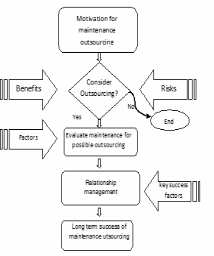
Benefits of outsourcing
Available literature has partially evaluated the benefits of outsourcing with specific reference to the maintenance function. However, organizations can derive numerous benefits through outsourcing as evaluated herein.
Cost-saving
Cost minimization is one of the fundamental aspects that organizations consider in their strategic management practices. Outsourcing constitutes one of the strategies that firms are adopting to minimize the different components of cost, which include the fixed cost, variable cost, and cost of labor. However, in a bid to achieve cost minimization through outsourcing, organizational managers need to undertake an extensive cost analysis. Outsourcing is mainly applicable if the cost of undertaking a specific task in-house is higher than the cost of outsourcing (Nili, Shekarchizadeh & Shojaey 2012).
Outsourcing aids in achieving cost minimization in various ways. First, cost-saving is achieved from a reduction in the operation and maintenance costs. For example, outsourcing enables an organization to avoid the costs that arise from the depreciation of equipment. This goal is attained by integrating the latest technology without incurring up-front capital investment. Additionally, an organization’s competitiveness is improved by benchmarking its operations.
Start-ups and small enterprises might not have the financial capability to undertake the maintenance function from within by recruiting full-time technicians. On the contrary, such organizations can undertake the maintenance function successfully through outsourcing. Findings of a study conducted by McKinsey shows that an organization can reduce the cost of labor by approximately 25% and 33% through outsourcing human capital (Usher 2003). Outsourcing enables organizations to achieve cost-saving concerning labor cost due to the new technology adopted in executing the maintenance function. Conversely, a reduction in the cost of operation emanates from the contractor’s experience and expertise in performing specific tasks.
Risk sharing
Usher (2003) argues that outsourcing is an effective risk management technique by minimizing, eliminating, and sharing risk. Under the outsourcing strategy, risk-sharing arises from the partnership relationship between the outsourcing firm [principle] and the outsourced firm [agent]. The two parties must work collaboratively, which leads to the emergence of mutual responsibilities and shared liabilities.
Refocusing on core competency
Due to outsourcing, an organization’s management team can build its core competency by seeking experts to undertake some of the tasks that a firm might not have the necessary capability to execute. Unlike the outsourcing firm, the outsourced consultants are self-contained, which means that they can effectively handle the task that seems challenging or non-core to an organization. Consequently, the organization’s top management team can refocus on the core organizational functions. Insinga and Werle (2000) affirm that outsourcing adds value to an organization’s service delivery process. Subsequently, an organization’s ability to produce the desired value is increasing significantly.
Cost minimization comprises one of the main motivators in adopting the outsourcing strategy. However, Usher (2003) is of the view that the outsourcing decision should not be exclusively based on cost. On the contrary, organizational managers must evaluate the likely value that it will derive from outsourcing. Therefore, the probability that the concept of outsourcing will shift from solely being a matter of cost minimization to value addition is considerably high. Some of the value-added elements that organizations will focus on in their outsourcing process include growth in return on investment, developing best practices, achieving overall operational efficiency, and enhancing economies of scale.
Economy of scale
Outsourcing enables an organization to achieve economies of scale through cost reduction due to minimal errors, hence the need for repetition. The outsourced firm ensures that optimal overhead control measures are incorporated. The economy of scale is also achieved as an organization gains the best practices, hence reducing operational inefficiencies. Furthermore, outsourcing leads to growth in an organization’s market share.
Time-saving
Achieving high operational efficiency can contribute to an organization’s quest for a high competitive advantage. According to Tayauova (2012), organizations are motivated to outsource some activities by the need to save time in executing certain activities. Outsourcing fosters time-saving due to the expertise of the service provider. Subsequently, the human capital deficiencies that might limit a firm from undertaking the specific tasks are eliminated. Moreover, the need to undertake staff restructuring and employee training to achieve operational efficiency is eliminated. Saving time contributes to an organization’s overall performance as the top management focuses on executing the core business activities. According to Insinga and Werle (2000), most organizations have not appreciated the importance of saving time in their quest to maximize productivity. Thus, the most cost-benefit analysis ignores time-saving as one of the variables in achieving the desired level of productivity.
Flexibility
Nili, Shekarchizadeh, and Shojaey (2012) think that flexibility is a critical strategic factor and it is closely related to cost-saving. In the course of their operation, organizations must develop different types of flexibility, which include demand, resource, and operational flexibility. Nili, Shekarchizadeh, and Shojaey (2012, p. 25) corroborate that the ‘potential for improved flexibility is measured by the organization’s ability to change its service delivery process to respond to the changing market conditions’. The dynamic nature of the business environment requires organizations to respond to changing customer demands. Outsourcing remarkably improves an organization’s flexibility by reducing the amount of time that is required to complete a particular task.
In a bid to achieve a competitive advantage concerning undertaking corrective maintenance, rapid response and speed are critical. Through outsourcing, an organization pressurizes the outsourced firm to ensure that the services are executed optimally.
According to Insinga and Werle (2000, p.63), ‘ninety-four percent of organizations cite flexibility and adaptability as their main reason for seeking the outsourcing strategy’. Outsourcing enables organizations to achieve flexibility in different ways. First, the probability of dealing with a workload that would have proved challenging is increased remarkably by transferring such responsibility to the outsourced entity. Furthermore, an organization is not required to adjust its workforce structure, for example, by increasing the number of employees to undertake the task successfully. Increasing the size of human capital might increase the cost of operation because the person might not be adequately engaged during the low or unproductive periods.
Quality improvement
Service quality is a critical element in determining the repeat purchase behavior amongst customers. Nili, Shekarchizadeh, and Shojaey (2012) argue that organizational managers should not underestimate the importance of investing in effective quality planning, assurance, improvement, and control. If an organization perceives quality as a critical factor in attaining sustainable competitive advantage, outsourcing should be considered as a potential aspect to achieve continuous improvement. Insinga and Werle (2000, p. 66) hold that organizations’ ‘decision to adopt the outsourcing strategy should be based on the commitment to meeting specific client requirements and reaching high service level’.
Organizations can enhance their competitive edge by outsourcing non-core activities. ADNOC Distribution is committed to offering efficient automobile maintenance service within its service stations. Nevertheless, the likelihood of achieving this goal might be diminished by different factors such as wear and tear of the maintenance equipment, changing operational requirements, and technological developments. ADNOC Distribution must comply with the car maintenance standards stipulated by the UAE government.
Challengers associated with outsourcing
Despite the benefits associated with outsourcing, organizational leaders must appreciate the existence of risks (Insinga & Werle 2000). The risk of outsourcing mainly emanates from the lack of a well-designed methodology that organizational managers can adopt in implementing the strategy. The outsourcing industry is characterized by diverse risk categories as evaluated herein.
Operational risk
Outsourcing entails transferring certain work processes to external clients based on a contractual agreement. However, such a strategy might hinder an organization’s operational efficiency. For example, the client might not develop an adequate understanding of the clients’ requirements. Moreover, failure to undertake an extensive analysis of the outsourced firm might lead to the selection of a poor service provider. Consequently, an organization might not achieve the desired outcome. Nili, Shekarchizadeh, and Shojaey (2012) affirm that operational risk might also arise from the view that the outsourced firm might lose control of its function. Moreover, Insinga and Werle (2000, p. 58) affirm that outsourcing at ‘the operational level can easily lead to the development of dependencies that create unforeseen strategic vulnerabilities’. This aspect underscores the importance of incorporating a systematic methodology that should serve as the guide in implementing the outsourcing strategy.
Strategic risks
Contracted service providers might develop opportunistic behavior. One of the core responsibilities of the outsourced firm is to offer consultancy services. However, to achieve this goal, the principal [the outsourcing firm] must provide the service provider with adequate information on its operational strategy. The outsourced firm might steal confidential information such as intellectual property rights, which might jeopardize the organization’s long-term competitiveness. This risk might arise from the existence of moral problems amongst the outsourced firm’s employees.
Understaffing is another strategic risk associated with outsourcing. According to Insinga and Werle (2000), the service provider might double the cost of providing the service during the renewal of the contract after making sure that it is difficult for the outsourcing firm to pull out of the existing contractual relationship.
Composite risk
This type of risk arises in situations whereby an organization has continuously implemented the concept of outsourcing for a considerably long duration like 10 years. In such situations, the client company might not have developed the necessary operational capabilities to assist in sustaining its long-term competitiveness upon the expiry of the contract period.
To manage composite risk, organizational leaders must focus on developing core competencies concerning the services being offered by the contracted firm. Conversely, strategic and operational risk can be managed by integrating effective preventative measures. One of the principal preventative measures that firms can adopt entails undertaking effective planning on the outsourcing initiative. For example, effective continuous accountability should be entrenched in planning the outsourcing function. However, most organizations are yet to appreciate the importance of accountability in the outsourcing process. Organizational managers should recognize that outsourcing certain operational activities do not include giving out the accountability role. On the contrary, the responsibility to ensure accountability should be a preserve of the outsourcing firm.
Outsourcing might also be affected by a poor relationship between the firm and the service provider.
Linking outsourcing to business strategy
The concept of outsourcing has been in existence for a considerable duration. For example, the Coca-Cola Company had appreciated the importance of outsourcing by 1900. Furthermore, due to the lack of expertise concerning the production of bottles, the firm licensed an independent bottle manufacturing company, which oversaw the production of the bottles. On its part, the firm was concerned with undertaking the quality control function, which is considered as core in achieving competitive advantage. Through the outsourcing strategy, the Coca-Cola Company achieved market dominance due to its commitment to the core functions as the non-core activities were delegated to a third party.
This aspect shows that the effective implementation of the outsourcing strategy can enhance an organization’s long-term competitiveness and market dominance. However, Insinga and Werle (2000) emphasize that it is essential for organizational leaders to ensure that the outsourcing approach is aligned with the business strategy. Thus, an effective methodology to aid in establishing such alignment is critical. Insinga and Werle (2000) contend that the methodology should be based on a thorough systematic review of the different functional areas in an organization. Conducting such an analysis provides an organization’s management team with insight on how to establish an effective strategic basis to undertake the outsourcing process.
The methodology affirms that the business strategy should form the basis upon which the outsourcing strategy is formulated. Consequently, organizational managers should adopt the resource-based view in formulating the outsourcing strategy. The formulated outsourcing strategy should transform an organization’s resources into valuable, rare, difficult to imitate, and non-substitutable organizational assets (Insinga & Werle 2000). Figure 2 below illustrates a sample methodology that organizations can adopt to undertake a systematic view of their internal activities. The methodology involves categorizing the business activities into different categories, which include a key, commodity, basic, and emerging activities. Effective implementation of the methodology can assist organizations in determining the functions that should be outsourced.
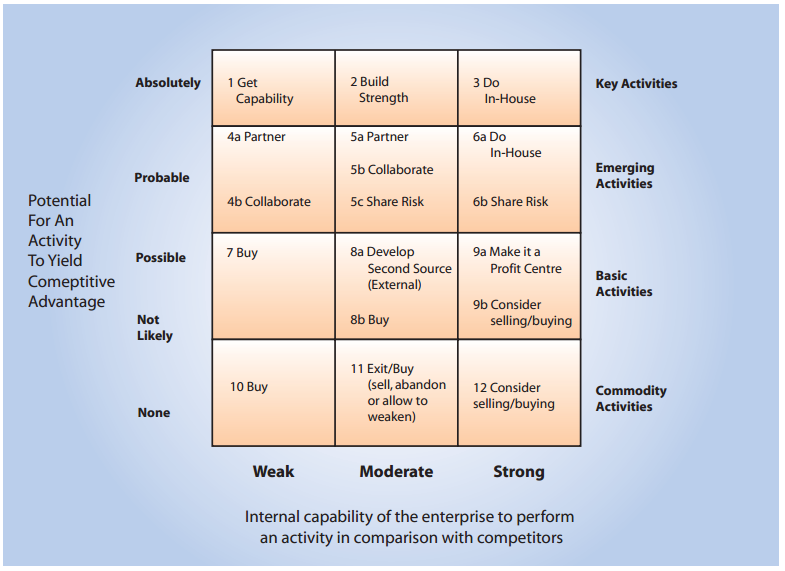
Development of the conceptual solutions
Methodology
The objective of this research study is to explore the application of the outsourcing strategy at ADNOC Distribution service stations with specific reference to the advantages and advantages. Furthermore, the study identifies the gaps concerning the firm’s maintenance function. The study has adopted a mixed research design by incorporating different research techniques as stipulated by the research onion outlined below.
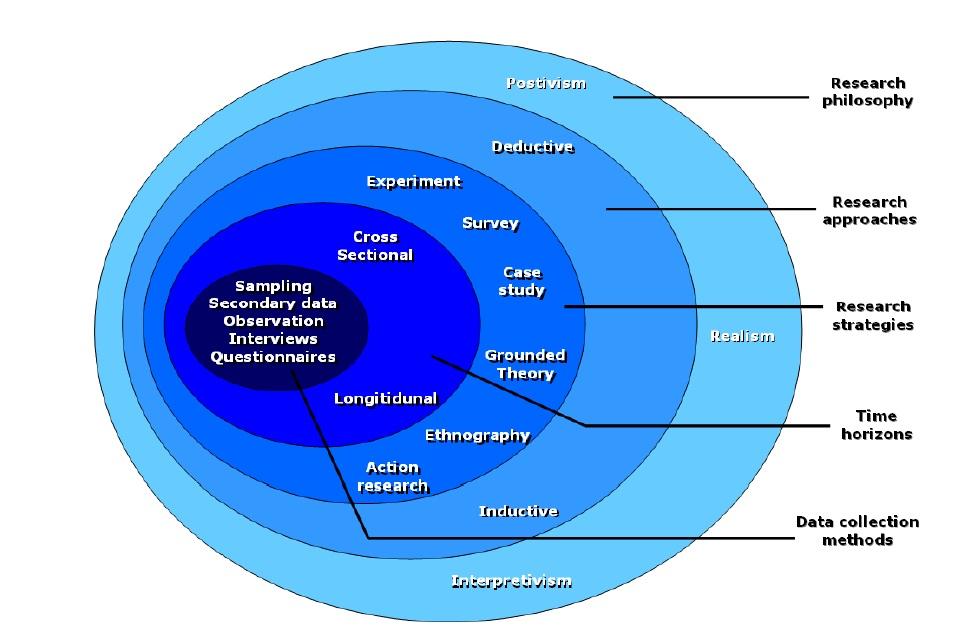
The research is based on a mixed research approach, which is achieved by integrating the qualitative research design. The choice of qualitative research design arose from the need to gather sufficient data from the field, hence increasing the likelihood of undertaking an in-depth exploratory study on the subject. The study also incorporates a quantitative research design to interpret, analyze, and interpret the research findings effectively.
The researcher targeted employees within ADNOC Distribution service stations exclusively, which constitutes the study population. However, the researcher recognizes the resource constraints associated with conducting a study on a large population. Consequently, a simple random sampling technique was adopted in constructing the sample study. By using random sampling, the researcher eliminated bias in selecting the respondents. The research sample was comprised of 100 employees selected from different service stations in the UAE. To gain a diverse perspective on the application of the outsourcing strategy at ADNOC service stations, the researcher considered employees at different levels of management.
The credibility of the data collected impacts the reliability of particular research findings. This study relies on primary data, which was achieved by adopting primary methods of data collection. The interviewing technique was adopted as the primary data collection method. Focus group interviews were conducted on the selected respondents. In a bid to ensure that the data collected was relevant to the research study, a set of open and close-ended questions were developed. The researcher thought that using the open and close-ended questionnaires would improve the probability of gathering sufficient data from the market. Incorporating open and close-ended questions provide respondents with discretion in responding to the questions. Furthermore, the likelihood of gaining a diverse perspective regarding the issue under investigation improves significantly.
The Likert scale was incorporated in the research questionnaire to assist the respondent to gather the necessary data. Through the Likert scale, the researcher gathered the respondent’s opinion on specific aspects such as the benefits associated with the outsourcing strategy.
The questionnaires were reviewed before their administration to the target audience. The review aimed at eliminating ambiguity, hence increasing the likelihood of achieving a high rate of response. The focus group interview was conducted electronically via online surveys to minimize the cost of the study, concerning time and money.
To improve the relevance of the collected data, it was analyzed using Microsoft Excel software. The software enabled the researcher to condense the research findings using different presentation tools such as charts, graphs, tables, and percentages. Furthermore, the software made it possible for the researcher to analyze the data quantitatively.
Case study analysis
ADNOC Distribution has partially integrated the concept of outsourcing, as evidenced by its decision to outsource the maintenance function at its service stations. The firm intends to sustain high competitiveness concerning the provision of diverse maintenance services at its service stations located in different regions in the UAE. Currently, the firm is in the initial stages of implementing the outsourcing strategy within its ADNOC Distribution Autoserv. The study showed that ADNOC Distribution is focused on attaining competitive advantage through outsourcing. However, the firm’s outsourcing strategy is characterized by significant gaps as analyzed herein.
The study showed that ADNOC Distribution is motivated to adopt the outsourcing strategy by diverse factors. Eighty-five percent (85%) of the respondents thought that ADNOC Distribution is motivated to adopt the outsourcing strategy by the need to achieve a competitive advantage. The respondents opined that the firm’s success in achieving this goal was dependent on the extent to which the firm developed internal core competencies. According to the respondents, the firm has developed adequate core competencies concerning several maintenance activities. Some of the outsourced activities include the maintenance of air conditioning units, automatic sliding doors, generators, neon lights, gas detection systems, minor painting works, fire alarms, and LV Substations. Others include maintenance and repairs [water proofing] of fuel dispensers, air gauge, cladding and signage, calibration of lube meters, air gauge, and fuel dispensers, accidental repairs, signage works- fleet vehicles, and maintenance of air curtains. This aspect shows that ADNOC Distribution has developed a broad service portfolio to meet diverse customer needs.
In a bid to understand the extent to which ADNOC Distribution has integrated the concept of outsourcing, the researcher evaluated whether the maintenance activities that the firm has outsourced are either core or non-core. The findings obtained from the respondents showed that the firm has identified several non-core activities. The respondents identified some non-core activities that the firm has outsourced in its service stations as illustrated by the chart below.
The above table shows that ADNOC Distribution has identified several non-core activities. The firm has outsourced the above activities to external service providers. Furthermore, the respondents thought that ADNOC Distribution conducts some of the maintenance activities in-house. The respondents thought that the maintenance activities are undertaken in-house mainly relate to the functions that the firm has developed sufficient core competence. Additionally, the study shows that the firm has limited outsourcing to non-core activities. Some of the core maintenance activities at the firm’s service stations are outlined in the table below.
To develop an ample understanding of outsourcing at ADNOC Distribution service stations, the researcher asked the respondents the factors that have driven the firm’s decision to outsource the maintenance function. Thirty percent (30%) of the respondents strongly cited the need to develop sufficient and relevant core competence as the main driver. The respondents believed that outsourcing enables ADNOC Distribution to offer efficient and effective car maintenance services.
Twenty-seven percent [27%] of the respondents thought that ADNOC Distribution’s outsourcing decision has arisen from the need to minimize the cost of operation. Conversely, 24% of the respondents argued that the firm has been driven by the need to access better skills and expertise, while only 19% of the respondents cited flexibility as the core driver. The graph below illustrates the variation in the respondents’ responses.
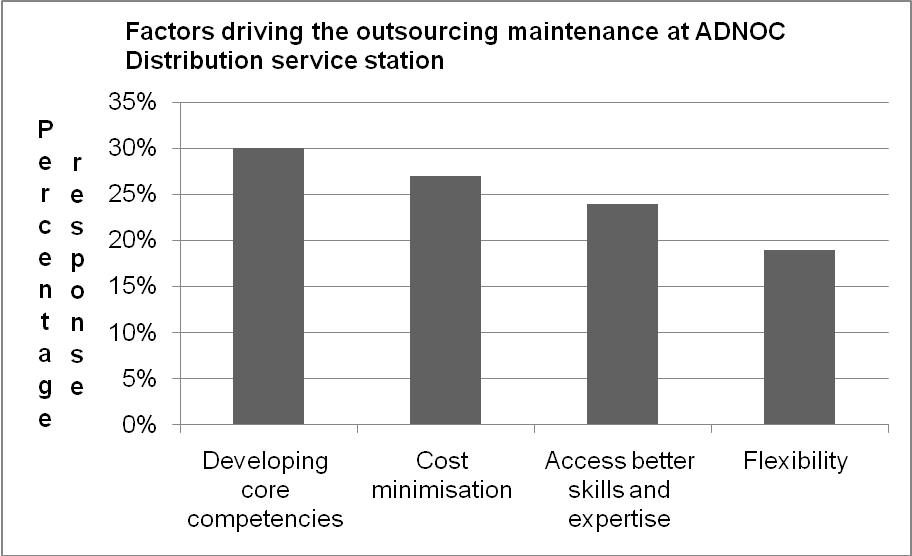
The respondents further cited different reasons that have stimulated ADNOC Distribution to adopt the above factors. Varying opinions were obtained regarding the firm’s commitment to developing core competencies. Forty-eight percent [48%] of the respondents thought that outsourcing provides ADNOC Distribution access to a wide variety of markets. According to these respondents, outsourcing the maintenance function has improved the attractiveness of the maintenance services offered at ADNOC Distribution service stations.
On the other hand, 39% of the respondents argued that outsourcing has enabled ADNOC Distribution service stations to achieve an optimal market position both in the UAE and around the Gulf region. According to the respondents, outsourcing has made it difficult for the firm’s competitors to imitate its services. However, this aspect indicates a significant gap in the organization’s quest to sustain its competitive advantage in the long-term due to over-dependence on the contracted firm in offering maintenance services. The relationship between ADNOC Distribution and the maintenance service provider is contractual. Therefore, breach of such a contract might affect the sustenance of the firm’s long-term competitiveness. Thirteen percent [13%] of the respondents argued that the concept has led to the improvement of perceived customer benefit, which is critical in influencing the consumers’ purchase decision.
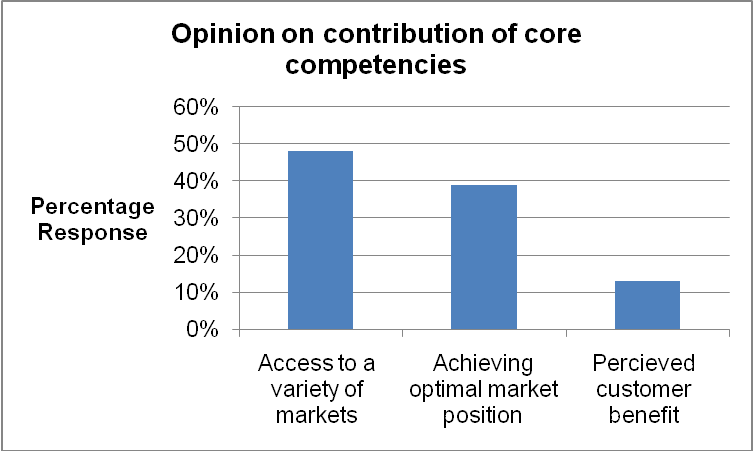
Concerning cost reduction, the respondents cited different cost reduction issues that the firm has taken into consideration. Twenty-three percent (23%) of the respondents argued that ADNOC Distribution’s decision to outsource the maintenance function at the service stations has arisen from the need to transfer fixed costs to variable costs. In their opinion, ADNOC Distribution has transferred the different fixed costs incurred in offering maintenance service to an external service provider, hence minimizing the overall cost of operation. Twenty-four percent [24%] of the respondents thought that ADNOC Distribution has significantly reduced the cost of operation by minimizing the requirement to make an extensive capital investment such as purchasing new maintenance technologies.
Twenty percent [20%] of the respondents thought that outsourcing has contributed to a high operational efficiency due to the expert knowledge of the contracted maintenance firm. Seventeen percent (17%) affirmed that the maintenance at the service stations has achieved economies of scale. The respondents affirmed that the firm’s service stations have achieved optimal equipment utilization, hence a high return on investment. Conversely, 17% of the respondents were of the view that the firm has eliminated maintenance expenses.
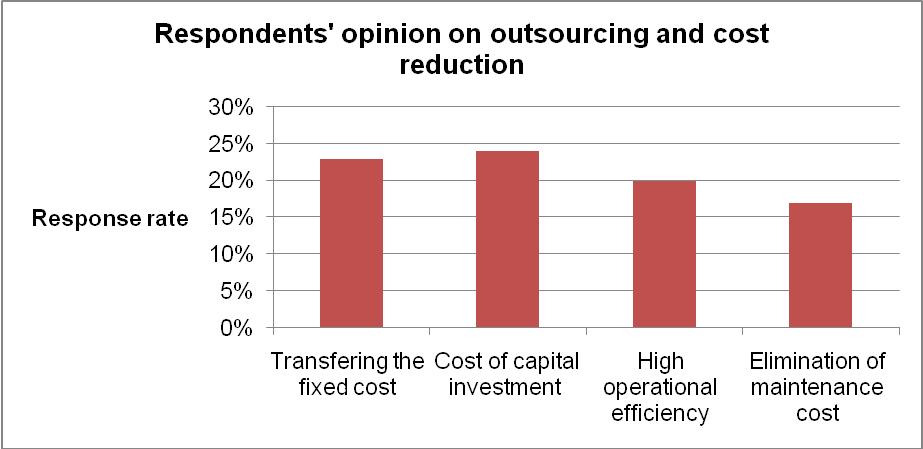
Graph 3 above shows that ADNOC Distribution’s decision to adopt the concept of outsources has arisen from the need to minimize the cost of investing in capital equipment to undertake the maintenance function. However, the lack of adequate ownership of the different maintenance equipment at the service stations presents a significant gap in the organization’s quest to offer high-quality services. In the event of a poor contractual relationship between ADNOC and the outsourced firm, the firm might lose its competitiveness due to a lack of the necessary tools and equipment to offer car maintenance services at the service stations. Integrating cost of capital investment as one of the motivators towards outsourcing shows that ADNOC Distribution is yet to appreciate the importance of developing a resource-based view with specific reference to physical resources in offering maintenance services.
Insinga and Werle (2000) hold that it’s essential for organizations to develop an effective methodology in formulating their outsourcing strategy. Thus, organizational managers should ensure that the outsourcing strategy adopted by the organization is aligned with the firm’s business strategy.
ADNOC Distribution recognizes the importance of transforming itself into a knowledge-based entity. This aspect is illustrated by the fact that the firm has been motivated to adopt outsourcing as a strategy to improve its workforce’s skills and expertise. Thirty-two percent [32%] of the respondents interviewed were of the view that the outsourcing strategy has enabled a significant proportion of the firm’s workforce to acquire new skills and expertise. Forty percent of the respondents [40%] affirmed that outsourcing has enabled the firm’s employees to access the latest technologies in the automobile maintenance industry. Thus, they are likely to become experts by utilizing the technologies in executing their maintenance function. Twenty-eight percent [28%] of the respondents argued that adopting the outsourcing strategy has enabled the organization to train and manage its staff on technological issues.
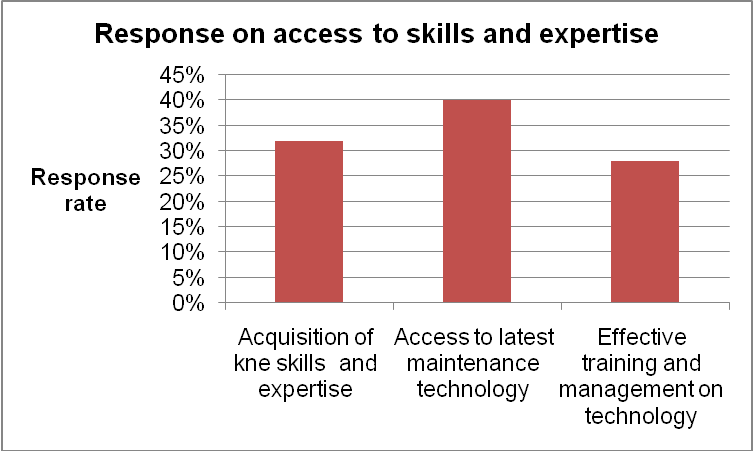
The contemporary oil and gas industry is undergoing remarkable transformation arising from different forces such as a change in customer needs. Consequently, the importance of organizations developing a high response rate should not be under-estimated. The study showed that ADNOC Distribution considers outsourcing as one of the most effective strategies that can contribute to a high degree of flexibility. Forty-five percent [45%] of the respondents were of the view that outsourcing has greatly enabled the organization to respond to the changing business environment by altering its business strategy, hence offering optimal car maintenance services. Similarly, 38% of the respondents affirmed that outsourcing has enabled the firm to undertake special and urgent car maintenance services. This goal is achieved due to the resulting collaboration between the firm and the contractor. Thus, the organization is in a position to achieve and exceed the customers’ expectations. Seventeen percent [17%] of the respondents emphasized that the strategy has led to the transfer of new services that enable the firm to address the changes occurring in the contemporary service station market segment.
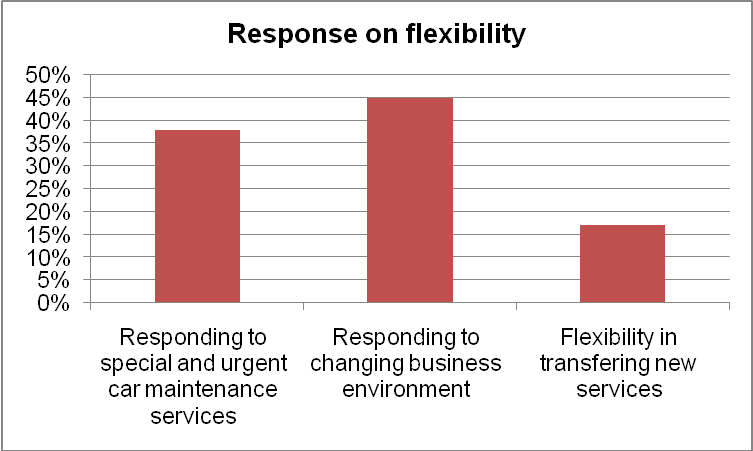
Conclusion and recommendations
The maintenance function especially in asset-intensive industries is critical in the quest to achieve sustainable competitive advantage. The significance of the maintenance function has stimulated organizations to shift from the reactive approach in undertaking the function to a proactive approach. Moreover, asset-intensive industries are progressively considering the maintenance function as a profit center as opposed to being a cost center. The above transformations have spurred the need for organizations to develop adequate competitiveness in executing the maintenance function.
The motivation to adopt the concept of outsourcing varies across different organizations. However, one of the most common motivators includes the need to achieve sustainable competitive advantages by developing core competencies in executing the maintenance function. Additionally, organizations’ inclination towards the outsourcing strategy is motivated by the need to minimize the cost of operation. Cost minimization constitutes one of the most important factors that organizations consider in implementing the outsourcing strategy.
The outsourcing strategy enables organizations to optimize their competitiveness by enhancing the transfer of knowledge, skills, and expertise. Such transfers arise from the collaboration between the principal and the service provider. In addition to the above aspects, organizations are motivated to integrate the outsourcing strategy by the need to minimize risk, achieve economies of scale, flexibility, and operational efficiency.
The case study shows that ADNOC Distribution intends to exploit the concept of outsourcing in developing an optimal competitive advantage in the oil and gas industry in the UAE and the Gulf region. The firm has partially implemented the outsourcing strategy, as the approach is only applicable to the maintenance function at all its service stations. ADNOC Distribution has adopted the concept of contracting as its core outsourcing strategy. The firm has achieved this goal by entering into a contractual relationship with different car maintenance companies such as Emirate Transport. Under this strategy, Emirate Transport is required to offer diverse car maintenance services at all the service stations in the UAE. On the other hand, ADNOC Distribution compensates Emirates Transport for the services offered. Under this strategy, Emirate Transport offers ADNOC Distribution diverse services such as consultancy in addition to actual maintenance of the clients’ vehicles.
The analysis shows that the firm’s decision to integrate the outsourcing strategy in undertaking the maintenance function at ADNOC Distribution service stations is multi-dimensional. First, the firm’s outsourcing strategy has been motivated by the need to eliminate the complexity associated with car maintenance. Therefore, one can argue that the nature of the firm’s outsourcing strategy is tactical. To achieve long-term competitiveness concerning outsourcing, the firm needs to appreciate and manage the risks associated with the outsourcing strategy.
The analysis shows that ADNOC Distribution is committed to achieving a sustainable competitive advantage concerning the provision of satisfactory services to its clients in all its service stations. However, this goal will depend on the effectiveness with which the firm executes the maintenance function. The firm has successfully identified some maintenance activities that are non-core to its operations. To succeed in its outsourcing strategy, the firm must consider the following aspects.
Resource-based view
Even though the outsourcing strategy is aimed at achieving operational efficiency, it should also contribute to long-term organizational performance. This goal can only be achieved if an organization developed internal capabilities. Therefore, the firm should not base its outsourcing strategy on a long-term approach. On the contrary, the outsourcing strategy should be sustained until the firm develops its internal capabilities concerning the outsourced function. By adopting such an approach, the likelihood of the firm enhancing its competitiveness improves considerably due to the new knowledge gained from the service vendor. This aspect will enable ADNOC Distribution to control the maintenance function fully. Thus, the firm will be fully accountable to its clients, hence establishing a long-term relationship with its clients.
Contractual relationship
ADNOC Distribution should ensure that the outsourcing contract is well developed. This aspect will aid in eliminating gaps that might limit the contribution of the strategy to the overall organization strategy. Furthermore, the firm should focus on developing a strong contractual relationship with the service vendor. This approach will play a fundamental role in sustaining the outsourcing relationship, hence its ability to sustain long-term competitive advantage. To develop and sustain such a relationship, the firm’s management team should ensure that the relationship is based on mutual trust. This aspect will minimize the likelihood of unethical behavior amongst the vendors’ employees. Consequently, the likelihood of offering satisfactory car maintenance services in all its service stations will be enhanced. The contractual relationship should be reviewed continuously to identify potential gaps that might affect the relationship adversely.
Linking the outsourcing strategy to the overall business strategy
Despite the view that the firm’s outsourcing strategy is based on a systematic review, the management team must evaluate the extent to which the outsourcing strategy fosters the overall business strategy. In a bid to ensure that the outsourcing strategy contributes to the firm’s business strategy adequately, ADNOC Distribution should evaluate the benefits gained from the implemented outsourcing strategy. Some of the aspects that the firm should consider entailing the level of customer loyalty and the effectiveness of the strategy in generating and transferring knowledge and expertise to employees.
Reference List
ADNOC: ADNOC Distribution; what is on the horizon.2015. Web.
Agha, S, Alrubaiee, L & Jamhour, M 2011, ‘Effect of core competence on competitive advantage and organisational performance’, International Journal of Business and Management, vol. 7, no.1, pp. 192-204.
Davis, R 2004, ‘Setting up and managing outsourcing contracts to deliver value and accommodate change’, Journal of Corporate Real Estate, vol. 6, no. 4, pp. 301-309.
Insinga, R & Werle, M 2000, ‘ Linking outsourcing to business strategy’, The Academy of Management Executive, vol. 14, no. 4, pp. 58-71.
Koszweska, M 2004, ‘Outsourcing as a modern management strategy; prospects for its development in the protective clothing market’, Autex Research Journal, vol. 4, no. 4, pp. 228- 231.
Nili, M, Shekarchizadeh, A & Shojaey, R 2012, ‘Outsourcing of maitenance activities in oil industry from Iran; benefits, risks and success factors’, Business and Management Review, vol. 2, no. 5, pp. 20-36.
Tarakci, H, Tang, K & Teyarachakul, S 2009, ‘Learning effects on maintenance outsourcing’, European Journal of Operational Research, vol. 192, pp. 138-150.
Tayauova, G 2012, ‘Advantages and disadvantages of outsourcing; analysis of outsourcing practices of Kazakhstan banks’, International Conference on Leadership, Technology and Innovation Management, vol. 41, pp. 188-195.
Usher, N 2003, ‘Outsource or in-house facilities management; the pros and cons’, Journal of Facilities Management, vol. 2, no. 4, pp. 351-359.
Wright, C 2004, ‘Top three potential risks with outsourcing information systems’, Information Systems Control Journal, vol. 5, no.1, pp. 1-3.